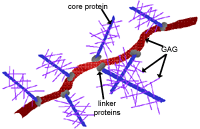The 'ground substance' of extracellular matrix is an amorphous gelatinous material. It is transparent, colourless, and fills the spaces between fibres and cells. It actually consists of large molecules called glycosoaminoglycans (GAGs) which link together to form even larger molecules called proteoglycans. These molecules are very good at absorbing water, rather like a sponge, such that 90% of the extracellular matrix is made up of water. This means that the ECM is very good at resisting compressive forces.
Extracellular Matrix - 'Ground substance'
What is Ground Substance?
Glycosoaminoglycans (GAGs)
These are unbranched polysaccharide chains, which are made up of long chains of repeating disaccharide units. One sugar residue in the pair is always an amino sugar (N-acetylglucosamine, or N-acetylgalactosamine) - hence the name aminoglycan. The other sugar residue is usually glucoronic or iduronic acid.
The most important thing to know about GAG's is that they are:
1. highly negatively charged, so they attract lots of cations
(i.e. sodium ions), which in turn causes lots of water to be sucked
into the matrix.
2. inflexible, as the long sugar chains cannot fold up like
proteins, so they remain extended and
3. strongly hydrophilic.
These properties mean that the GAG's form a matrix like a sponge, that sucks in lots of water, like a porous hydrated gel, and they are good at resisting compressive forces. This is particularly important for example in cartilage, a form of connective tissue, which is found in joints which have to withstand large compressive forces as we walk around. The extracellular matrix consists of 10% GAG's and most of the rest is water. This also makes nice big spaces for diffusion of molecules, and cells to move around in.
There are 4 main groups of GAG's:
The simplest GAG is hyaluronan (hyaluronic acid, hyaluronate). It is the simplest, because it does not contain sulphated sugars, or complex arrangements of a number of different disaccharide units, it has the longest chain (around 25,000 non-sulphated disaccharide units), it is not covalently linked to other proteins to make proteoglycans, and it is not made in the cell and released by exocytosis, but it is made by an enzyme complex at the cell surface. Because it is so large, it has a molecular weight of 8 x 106 and just fits into a cube of 300nm3, once it is hydrated with water. This means a small amount of GAG absorbs and swells up a large volume, so this GAG is a useful space-filler.
The other three types of GAGs are 1) chondroitin sulphate and dermatan sulphate, 2) heparan sulphate and heparin and 3) keratan sulphate. All three of these GAG's are sulphated, complex, small (around 300 units) secreted by the cell, and they are always found attached to a protein, forming a proteoglycan, see below.
A rare human genetic disease affects synthesis of dermatan sulphate.
Patients are dwarves, prematurely aged, and have defects in skin, joints muscles
and bones.
Proteoglycans

Proteoglycans are GAG's that are covalently attached to a 'core' protein. All GAG's except hyaluronic acid attach to a protein in this way. These GAG-protein mixtures are very heterogeneous, and this variability means they can form pores of different sizes to regulate the sizes of molecules that can move through the matrix. (An example is perlecan in the basal lamina of the glomerulus in the kidney). The proteoglycans perform many other functions, to do with regulation of enzyme and growth factor activity, too numerous to mention here (see Molecular Biology of the Cell if you want to know more).
One important proteoglycan is 'aggrecan' (shown in the diagram above) which is a major consituent of cartilage.